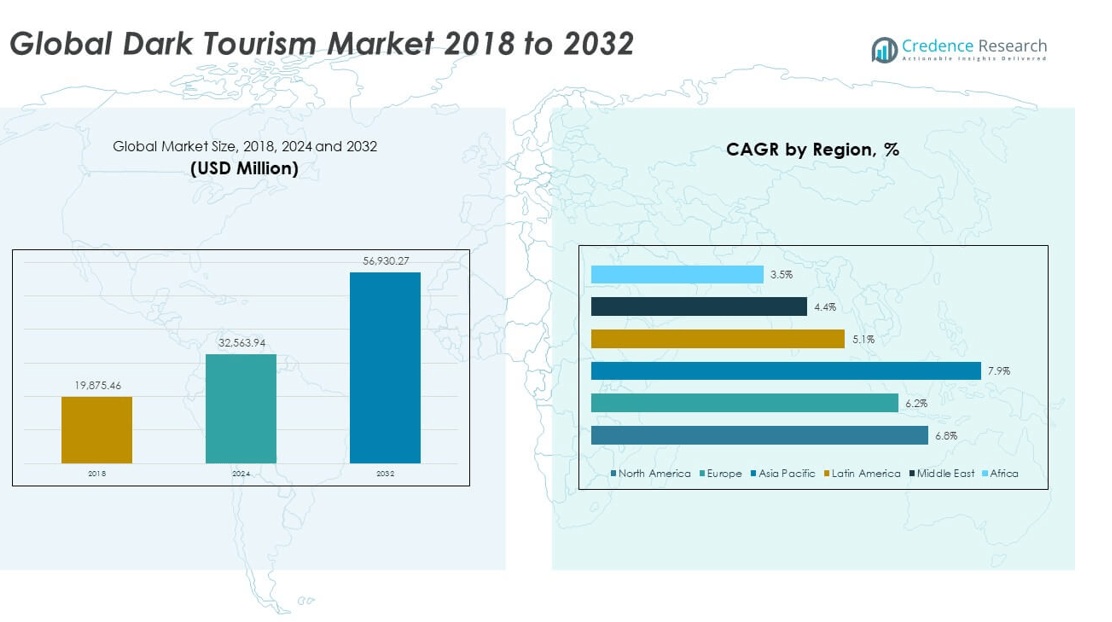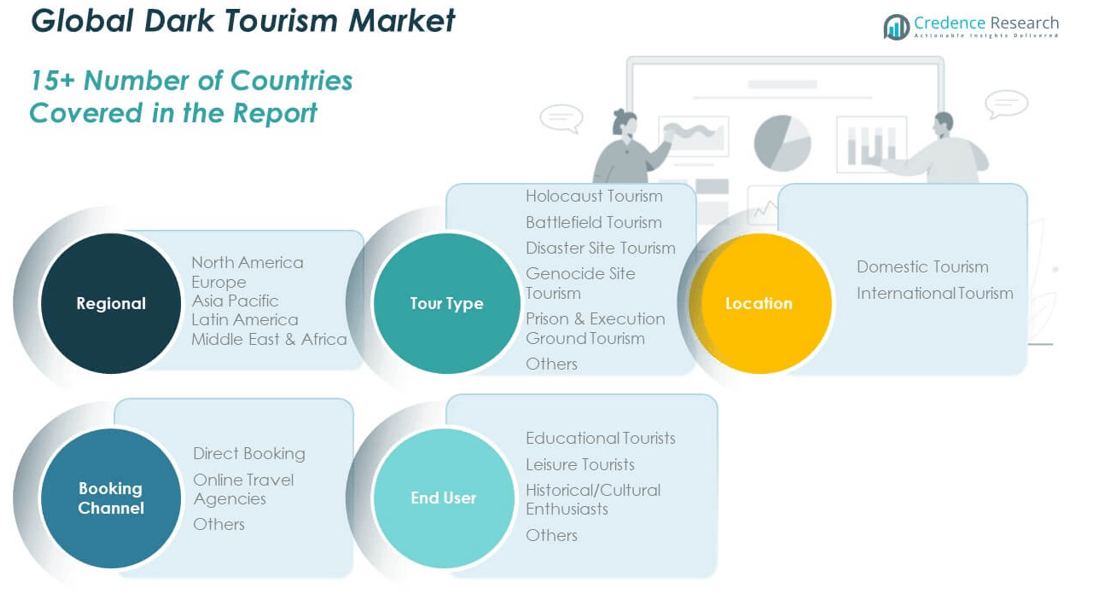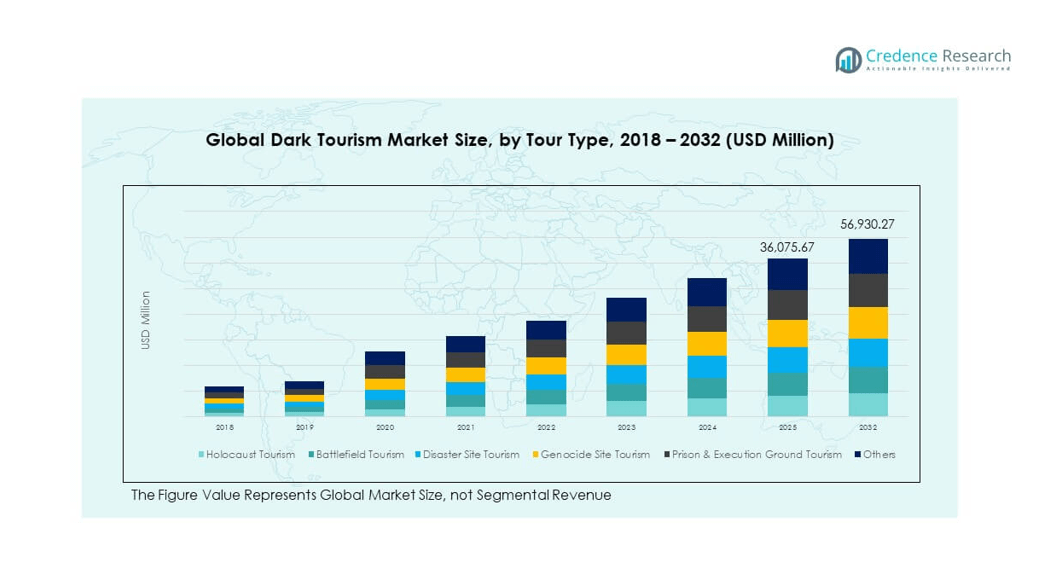CHAPTER NO. 1: GENESIS OF THE MARKET
1.1 Market Prelude – Introduction & Scope
1.2 The Big Picture – Objectives & Vision
1.3 Strategic Edge – Unique Value Proposition
1.4 Stakeholder Compass – Key Beneficiaries
CHAPTER NO. 2: EXECUTIVE LENS
2.1 Pulse of the Industry – Market Snapshot
2.2 Growth Arc – Revenue Projections (USD Million)
2.3. Premium Insights – Based on Primary Interviews
CHAPTER NO. 3: DARK TOURISM MARKET FORCES & INDUSTRY PULSE
3.1 Foundations of Change – Market Overview
3.2 Catalysts of Expansion – Key Market Drivers
3.2.1 Momentum Boosters – Growth Triggers
3.2.2 Innovation Fuel – Disruptive Technologies
3.3 Headwinds & Crosswinds – Market Restraints
3.3.1 Regulatory Tides – Compliance Challenges
3.3.2 Economic Frictions – Inflationary Pressures
3.4 Untapped Horizons – Growth Potential & Opportunities
3.5 Strategic Navigation – Industry Frameworks
3.5.1 Market Equilibrium – Porter’s Five Forces
3.5.2 Ecosystem Dynamics – Value Chain Analysis
3.5.3 Macro Forces – PESTEL Breakdown
3.6 Price Trend Analysis
3.6.1 Regional Price Trend
3.6.2 Price Trend by Service
CHAPTER NO. 4: KEY INVESTMENT EPICENTER
4.1 Regional Goldmines – High-Growth Geographies
4.2 Service Frontiers – Lucrative Service Categories
4.3 End User Sweet Spots – Emerging Demand Segments
CHAPTER NO. 5: REVENUE TRAJECTORY & WEALTH MAPPING
5.1 Momentum Metrics – Forecast & Growth Curves
5.2 Regional Revenue Footprint – Market Share Insights
5.3 Segmental Wealth Flow – Tour Type & Booking Channel Revenue
CHAPTER NO. 6: TRADE & COMMERCE ANALYSIS
6.1. Import Analysis by Region
6.1.1. Global Dark Tourism Market Import Revenue By Region
6.2. Export Analysis by Region
6.2.1. Global Dark Tourism Market Export Revenue By Region
CHAPTER NO. 7: COMPETITION ANALYSIS
7.1. Company Market Share Analysis
7.1.1. Global Dark Tourism Market: Company Market Share
7.2. Global Dark Tourism Market Company Revenue Market Share
7.3. Strategic Developments
7.3.1. Acquisitions & Mergers
7.3.2. New Service Launch
7.3.3. Regional Expansion
7.4. Competitive Dashboard
7.5. Company Assessment Metrics, 2024
CHAPTER NO. 8: DARK TOURISM MARKET – BY TOUR TYPE SEGMENT ANALYSIS
8.1. Dark Tourism Market Overview by Tour Type Segment
8.1.1. Dark Tourism Market Revenue Share By Tour Type
8.2. Holocaust Tourism
8.3. Battlefield Tourism
8.4. Disaster Site Tourism
8.5. Genocide Site Tourism
8.6. Prison & Execution Ground Tourism
8.7. Others
CHAPTER NO. 9: DARK TOURISM MARKET – BY LOCATION SEGMENT ANALYSIS
9.1. Dark Tourism Market Overview by Location Segment
9.1.1. Dark Tourism Market Revenue Share By Location
9.2. Domestic Tourism
9.3. International Tourism
CHAPTER NO. 10: DARK TOURISM MARKET – BY BOOKING CHANNEL SEGMENT ANALYSIS
10.1. Dark Tourism Market Overview by Booking Channel Segment
10.1.1. Dark Tourism Market Revenue Share By Booking Channel
10.2. Direct Booking
10.3. Online Travel Agencies
10.4. Others
CHAPTER NO. 11: DARK TOURISM MARKET – BY END USER SEGMENT ANALYSIS
11.1. Dark Tourism Market Overview by End User Segment
11.1.1. Dark Tourism Market Revenue Share By End User
11.2. Educational Tourists
11.3. Leisure Tourists
11.4. Historical/Cultural Enthusiasts
11.5. Others
CHAPTER NO. 12: DARK TOURISM MARKET – REGIONAL ANALYSIS
12.1. Dark Tourism Market Overview by Region Segment
12.1.1. Global Dark Tourism Market Revenue Share By Region
12.1.2. Region
12.1.3. Global Dark Tourism Market Revenue By Region
12.1.4. Tour Type
12.1.5. Global Dark Tourism Market Revenue By Tour Type
12.1.6. Location
12.1.7. Global Dark Tourism Market Revenue By Location
12.1.8. Booking Channel
12.1.9. Global Dark Tourism Market Revenue By Booking Channel
12.1.10. End User
12.1.11. Global Dark Tourism Market Revenue By End User
CHAPTER NO. 13: NORTH AMERICA DARK TOURISM MARKET – COUNTRY ANALYSIS
13.1. North America Dark Tourism Market Overview by Country Segment
13.1.1. North America Dark Tourism Market Revenue Share By Region
13.2. North America
13.2.1. North America Dark Tourism Market Revenue By Country
13.2.2. Tour Type
13.2.3. North America Dark Tourism Market Revenue By Tour Type
13.2.4. Location
13.2.5. North America Dark Tourism Market Revenue By Location
13.2.6. Booking Channel
13.2.7. North America Dark Tourism Market Revenue By Booking Channel
13.2.8. End User
13.2.9. North America Dark Tourism Market Revenue By End User
13.3. U.S.
13.4. Canada
13.5. Mexico
CHAPTER NO. 14: EUROPE DARK TOURISM MARKET – COUNTRY ANALYSIS
14.1. Europe Dark Tourism Market Overview by Country Segment
14.1.1. Europe Dark Tourism Market Revenue Share By Region
14.2. Europe
14.2.1. Europe Dark Tourism Market Revenue By Country
14.2.2. Tour Type
14.2.3. Europe Dark Tourism Market Revenue By Tour Type
14.2.4. Location
14.2.5. Europe Dark Tourism Market Revenue By Location
14.2.6. Booking Channel
14.2.7. Europe Dark Tourism Market Revenue By Booking Channel
14.2.8. End User
14.2.9. Europe Dark Tourism Market Revenue By End User
14.3. UK
14.4. France
14.5. Germany
14.6. Italy
14.7. Spain
14.8. Russia
14.9. Rest of Europe
CHAPTER NO. 15: ASIA PACIFIC DARK TOURISM MARKET – COUNTRY ANALYSIS
15.1. Asia Pacific Dark Tourism Market Overview by Country Segment
15.1.1. Asia Pacific Dark Tourism Market Revenue Share By Region
15.2. Asia Pacific
15.2.1. Asia Pacific Dark Tourism Market Revenue By Country
15.2.2. Tour Type
15.2.3. Asia Pacific Dark Tourism Market Revenue By Tour Type
15.2.4. Location
15.2.5. Asia Pacific Dark Tourism Market Revenue By Location
15.2.6. Booking Channel
15.2.7. Asia Pacific Dark Tourism Market Revenue By Booking Channel
15.2.8. End User
15.2.9. Asia Pacific Dark Tourism Market Revenue By End User
15.3. China
15.4. Japan
15.5. South Korea
15.6. India
15.7. Australia
15.8. Southeast Asia
15.9. Rest of Asia Pacific
CHAPTER NO. 16: LATIN AMERICA DARK TOURISM MARKET – COUNTRY ANALYSIS
16.1. Latin America Dark Tourism Market Overview by Country Segment
16.1.1. Latin America Dark Tourism Market Revenue Share By Region
16.2. Latin America
16.2.1. Latin America Dark Tourism Market Revenue By Country
16.2.2. Tour Type
16.2.3. Latin America Dark Tourism Market Revenue By Tour Type
16.2.4. Location
16.2.5. Latin America Dark Tourism Market Revenue By Location
16.2.6. Booking Channel
16.2.7. Latin America Dark Tourism Market Revenue By Booking Channel
16.2.8. End User
16.2.9. Latin America Dark Tourism Market Revenue By End User
16.3. Brazil
16.4. Argentina
16.5. Rest of Latin America
CHAPTER NO. 17: MIDDLE EAST DARK TOURISM MARKET – COUNTRY ANALYSIS
17.1. Middle East Dark Tourism Market Overview by Country Segment
17.1.1. Middle East Dark Tourism Market Revenue Share By Region
17.2. Middle East
17.2.1. Middle East Dark Tourism Market Revenue By Country
17.2.2. Tour Type
17.2.3. Middle East Dark Tourism Market Revenue By Tour Type
17.2.4. Location
17.2.5. Middle East Dark Tourism Market Revenue By Location
17.2.6. Booking Channel
17.2.7. Middle East Dark Tourism Market Revenue By Booking Channel
17.2.8. End User
17.2.9. Middle East Dark Tourism Market Revenue By End User
17.3. GCC Countries
17.4. Israel
17.5. Turkey
17.6. Rest of Middle East
CHAPTER NO. 18: AFRICA DARK TOURISM MARKET – COUNTRY ANALYSIS
18.1. Africa Dark Tourism Market Overview by Country Segment
18.1.1. Africa Dark Tourism Market Revenue Share By Region
18.2. Africa
18.2.1. Africa Dark Tourism Market Revenue By Country
18.2.2. Tour Type
18.2.3. Africa Dark Tourism Market Revenue By Tour Type
18.2.4. Location
18.2.5. Africa Dark Tourism Market Revenue By Location
18.2.6. Booking Channel
18.2.7. Africa Dark Tourism Market Revenue By Booking Channel
18.2.8. End User
18.2.9. Africa Dark Tourism Market Revenue By End User
18.3. South Africa
18.4. Egypt
18.5. Rest of Africa
CHAPTER NO. 19: COMPANY PROFILES
19.1. Atlas Obscura
19.1.1. Company Overview
19.1.2. Service Portfolio
19.1.3. Financial Overview
19.1.4. Recent Developments
19.1.5. Growth Strategy
19.1.6. SWOT Analysis
19.2. Dark Rome Tours
19.3. Dark Tourism Group
19.4. Anne Frank House
19.5. Auschwitz-Birkenau Memorial and Museum
19.6. Hiroshima Peace Memorial Museum
19.7. Chernobyl Tour
19.8. Titanic Belfast
19.9. Haunted History Tours
19.10. Ground Zero Museum Workshop









